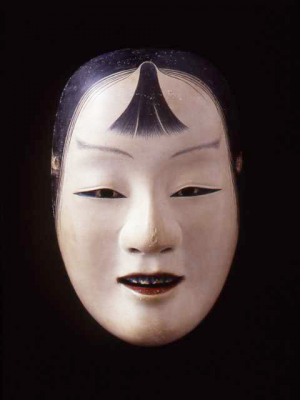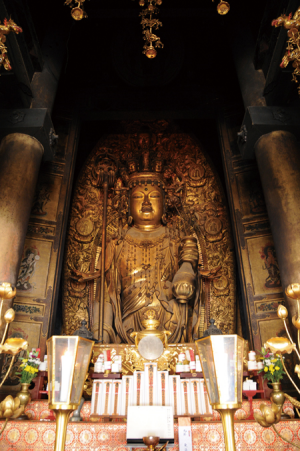(Boylove Documentary Sourcebook) - "The Story of Kannon's Manifestation as a Youth" by Anonymous, Early 14th Century (full-text short story)

From Partings at Dawn: An Anthology of Japanese Gay Literature, edited by Stephen D. Miller (San Francisco: Gay Sunshine Press, 1996). Footnotes omitted.
Note: This "acolyte tale" was written at a time when Japan followed the East Asian age reckoning, by which a person is considered to be one year old at birth, with age being incremented at the beginning of the lunar or solar year.[1]
Anonymous, Early 14th Century
The ostensible point of Chigo Kannon Engi is to explain the origin of the 11-faced Kannon enshrined in a subtemple of Kōfukuji in Nara. Another facet of the story is an assertion of the reliability of this deity, which the protagonist briefly doubts. Most interesting, however, is the fact that the tale shows a Buddhist deity facilitating a love affair for a lonely monk, who, insofar as he is associated with the Tendai school, should have been committed to upholding the precepts which strictly require celibacy. Chigo Kannon Engi and other literary sources reveal, however, that in medieval Japan there was deep ambivalence among monks regarding the applicability of the precept that forbade all sexual activity to intimate relations between men.
A beautifully illustrated version of the tale has been published in Nihon Emaki Taisei, vol. 24, Chūokōronsha, 1979.
Long ago near Hasedera in Yamato Province there was a revered monk. In his meditative practices he never rested from striving to attain ultimate understanding of the universe through his own body. In seeking perfect Buddhahood through the five stages he had for many years enjoyed the support of the Buddha in his practices and had accumulated religious merit. He was now over sixty years old. However, he had no disciple to serve him intimately, to carry on the services in honor of the Buddhist law, or to pray for his salvation in the world to come. Lamenting the paucity of his store of karma, he undertook to make a monthly pilgrimage to the deity Kannon of Hasedera temple for three years.
“Please grant me a disciple who will serve me on intimate terms and who will follow in my place after my death,” he prayed. Though he fulfilled his three-year vow, he received no answer to his prayer. Despite his resentment, he renewed his vow for three more months of pilgrimage to Kannon. After three years and three months there was still no divine sign. At this time the monk, regretting his fate, complained, “The great Kannon is the heir apparent of the Pure Land Paradise and Lord of the Realm of Potalaka. He is unwavering in his compassionate vow to save every sentient being in the world. I alone am excluded from his vow of impartiality and discriminated against. They say his light shines in every pool of water without distinction, but his reflection is not illuminating the muddy waters of my heart. His power does not extend so far. I regret that the clouds of my past transgressions cannot be dispersed.”
At dawn, setting off for home, he descended the mountain. As he was passing through the foothills of Obuse Mountain, he saw a youth of thirteen or fourteen, of complexion pale as the moon and adorned with flower-like magnificence. Over a purple underrobe he wore a garment of white silk and a hakama the color of fallen leaves. He played a melancholy tune on a Chinese flute. He wore a bamboo ornament in his long, sleek hair. Damp with the dew of the dawn of the eighteenth day of the eighth month, he was more graceful than a willow bending in a spring breeze. The sight made the monk wonder if he were not dreaming. Though he thought it might be a demon in disguise, he approached the lad and asked, “It is very strange for someone to be standing here alone in a moor like this so late at night. Who are you?”
The youth answered, “I am from Tōdaiji but I have run away because my master is annoyed with me. Where are you from? A monk’s compassion is said to be profound. Oh, please take me with you. I beg you.”
The monk was delighted. “You must tell me what happened. If I am to hear all about it, you’ll have to come along with me now.” He headed for home with the boy in his company.
The monk was overjoyed. Days passed, but no one came looking for the youth, who did all he could to please the monk. The monk in turn, shared his incomparable talents in poetry and music, and passed the months and years in the firm belief that his joy was due to the grace of Kannon.
Three years later, towards the end of spring, the youth became slightly indisposed. Day by day he weakened, until, on the verge of death, he pillowed his head on the monk’s knee. The monk took his hand, and brought his face close to the youth. Together they lamented their parting. The youth’s last words were deeply touching. “For these three years I have passed my days in a dwelling of compassion, my nights have been spent at the foot of walls of forbearance. Morning and evening you taught me with kindness I shall never forget, even in lives to come. Though they say that the old do not necessarily die before the young, I have thought only of outliving you so that I might hold memorial services for your salvation. My hopes have been in vain, my only regret is that I am going first. A master-disciple relationship is a bond for three lifetimes, so we will meet again in our next incarnations. Now, when I have breathed my last breath and expired, do not bury me in the ground with a marker, nor turn my body to smoke above the moor. Instead put my body in a coffin and place it in front of the altar. Then, on the thirty-fifth day, you are to open it.” He had barely finished speaking when he breathed his last. His spirit left his body, his life expired like the dew on Mount Hokubō.
The monk was overwhelmed with grief. When a bird faces death, its cry is meek, when a person faces a parting, his words are doleful. The monk sorrowfully remembered the youth’s last words and spoke repeatedly of times past. How piteous! To mourn the loss of a loved one is the way of the world, but the intensity of the monk’s grief was something not often witnessed. One who delights in the blossoms of spring laments their scattering, and the person who sings the praises of the late autumn moon resents the clouds which obscure the sky. Believing it all the divinely devised response to his three years and three months of pilgrimages to Hasedera, the monk’s love for the boy had been unparalleled. Suddenly parted after having loved one another for three years and three months, the intensity of the monk’s grief was natural. It seemed to him that some cloud obscured the youth’s moon-like visage, that a breeze had lured away the flower-like figure of his beloved. The tears of despair that a youth had passed on before an aged man repeatedly dampened his robe. When would he be able to forget this parting of master and disciple? How piteous! He who was approaching old age remained, while the youth was gone. He was reminded of fresh buds being scattered and of the cruelty of the turning of the autumn leaves. As the dew on the tip of a branch or the droplets at the foot of a tree both vanish, life, whether long or short, inevitably ends. He wept.
The monk could not go on like that, however, and so he placed the youth’s body in a coffin. Following the lad’s last instructions, he put the coffin before the altar and diligently performed the memorial services. People gathered from nearby villages and distant mountains to copy out the whole Lotus Sutra in one day and dedicated their work to the youth’s salvation. When the memorial service sermons were over, and, in an excess of emotion, the monk raised the lid of the coffin, a wonderful scent of sandalwood and jinsui incense filled the room. Having transformed from his previous appearance as a beautiful youth, there stood a golden eleven-faced Kannon. His eyes sparkled like the green leaves of the lotus, his red lips were set in a solemn expression, and he held a lotus blossom in his hand.
He addressed the monk with the voice of a bird of paradise. “I am not a human being. The Lord of Fudaraku is called the great Kannon. That is who I am. In order to bring salvation to all who trust in me, I have lived for some time at the foot of Mt. Hase. Because of the earnestness with which you made pilgrimages for many years, I took the form of a youth, one of my thirty-three manifestations and entered into a bound of two life-times with you. Seven years from now, on the fifteenth of the eighth month, I will come to escort you to the Pure Land. At our reunion we will be together on a lotus petal in the ninth and highest grade of paradise.” Light shone from his body and he ascended into the sky like lightning and disappeared behind a purple cloud.
It was a manifestation of the Chigo Kannon of Bodai’in in Nara. Anyone who makes a pledge, performs pilgrimages, and accumulates merit will be blessed with divine favor and will surely witness a manifestation of the youth. In addition it is said that those who come from near and far to transcribe and dedicate copies of the Lotus Sutra experience enlightenment and witness manifestations of Kannon. The true ambition of the Buddhas of the past, present, and future to save all sentient beings is realized in the saving power of the great Kannon.

References
See also
- Bishōnen
- Boylove
- Ephebophilia
- Historical boylove relationships in Japan
- Nanshoku
- Pederasty
- Samurai
- Shōnen
- Shotacon
- Shudō
- The Great Mirror of Male Love (book)
- Wakashū